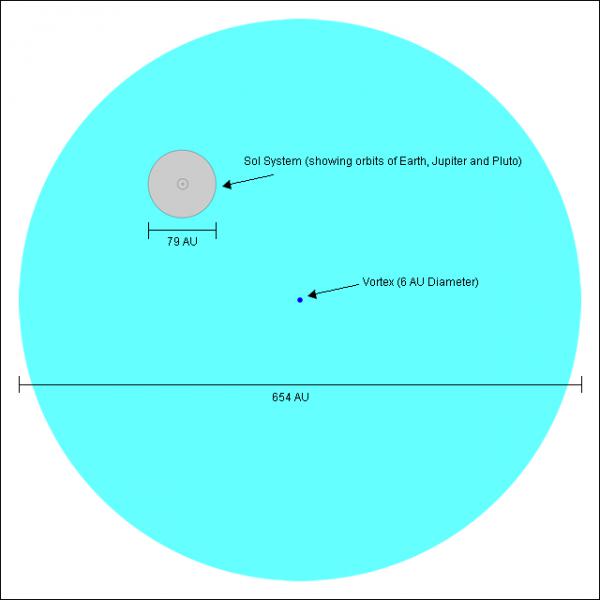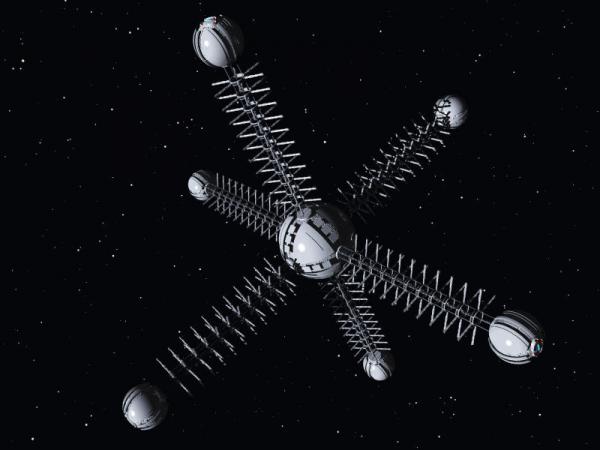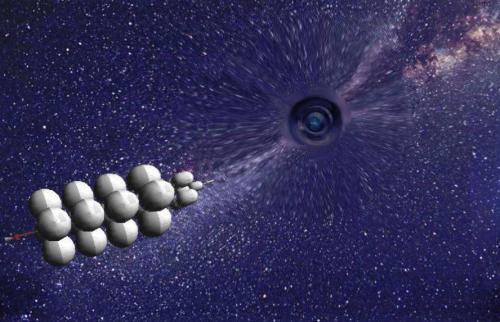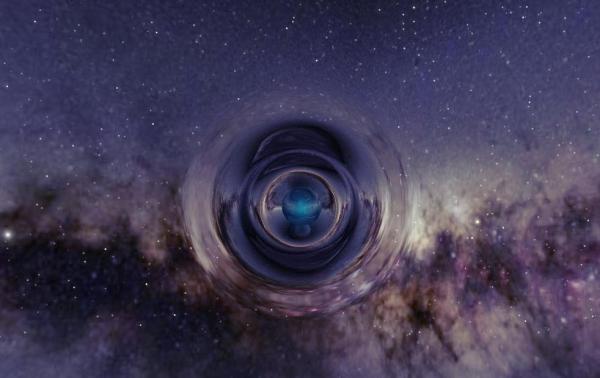BY LETTER
Wormhole Termini
Technology > Application > Transportation > Interstellar Transport
Technology > Application > Metric Engineering
Technology > Technology Type or Material > Space-Time Engineering
Technology > Technology Levels > Transapientech / Godtech / Clarketech
Technology > Application > Metric Engineering
Technology > Technology Type or Material > Space-Time Engineering
Technology > Technology Levels > Transapientech / Godtech / Clarketech
Wormhole stations located near, and within, wormholes | |
 Image from Chris Shaeffer | |
| Size Comparison The Transition Zone around a standard traversable wormhole, compared to the size of the Old Solar System (Solsys). This zone must be free of any massive object, such as a star, planet or moderately large asteroid. For this reason wormholes are situated far from the centre of most planetary systems | |
Wormhole termini are permanent space stations, supporting customs systems, defense outposts, communications links and so on, which are located near a traversable wormhole. A wormhole is a very extensive, highly distorted region in spacetime, and termini that are located in normal space outside the wormhole must be at least 327 AU from the wormhole throat. Such termini are known as Entry and Exit stations, and experience no tidal effects from the wormhole itself.
However it is possible to locate wormhole termini closer to the throat, within the so-called Transition zone, which extends from 327 AU to 3 AU from the wormhole throat. These stations, known as Transition Stations, are affected by tidal effects from the wormhole to a greater or lesser extent, but these effects are manageable. A macroscale traversable wormhole, known also as a Morris-Thorne-Kuhfittig wormhole, can be regarded as an extended object which distorts space-time over a much larger volume than a black hole of equivalent mass. Larger stations need to be further from the centre of the wormhole to avoid excessive effects.
Not all wormholes have Transition stations; many wormholes do not have Entry and Exit stations either, while some have both.
Because Transition stations are in circular orbits, they experience minimal shear stress from the local curvature of spacetime around the wormhole. However craft accelerating towards or away from such orbiting stations will experience shear stresses, which increase in strength towards the inner edge of the Transition Zone.
Transition Stations and spacecraft awaiting a path through the hole may remain in the Transition zone, as long as the total mass of such structures does not exceed 1% of the mass of the 'hole itself. Traversable wormholes are very massive, particularly in the Inner Sphere and Middle Regions, so such limits are rarely a concern. The Transition zone is an expanse of empty space surrounding the wormhole which must be kept free from massive objects in order to maintain the requirement for a region of asymptotically flat space surrounding the hole.
 Image from Chris Shaeffer | |
| Einstein Station, located near the Einstein Gate between Sol and Tau Ceti | |
Inside the Transition zone is a region of increasingly curved space-time called the Vortex which is 3 AU in radius. Permanent structures cannot be located here, and spacecraft in this region are either moving radially towards the 'hole, or accelerating radially out of the hole after arrival. The Vortex zone and the 'hole itself together are sometimes known collectively as the starportal or stargate.
Appearance
From the vantage point of a Transition station just outside the Vortex zone, the distant wormhole throat is 3 AU away and is too small to be seen. Some minor distortion of background starfields may give the location away. Periodically a departing spacecraft may move off in the direction of the starportal. Before reaching the wormhole throat the ship must pass across the Vortex zone, where spacetime becomes increasingly distorted. As seen from such a craft, as it approaches the hole the distortion of background starfields becomes more and more apparent. Image from Steve Bowers | |
| A Grapeship carries a number of smaller units which come together and separate to travel to different destinations on route | |
Near the 'hole the most noticable effect at first is the divergent lens effect surrounding the wormhole throat. The throat itself is a spherical region of highly curved spacetime, which can be difficult to see; some stray light from stars at the far end sometimes comes through, but that light is distorted, and dispersed by the curvature of the throat. Stars near or behind the wormhole will also have their light bent by the hole's gravity. This can cause "Einstein ring" phenomena, as well as increased brightness of stars nearly behind the wormhole due to gravitational lensing.
Surrounding the spherical throat there is a very thin region of highly distorted space time called the Caustic. Multiple images of external objects can briefly seen as light rays wind around this region of sharply distorted space-time. If looking perpendicular to the path that gets you through the hole, a highly distorted image of the spacecraft may be seen since the light emitted will have gone a full circle. Unlike a mirror, a person in that location would see the back of his head; however the this image would be distorted to a band encircling the wormhole throat. In theory there should be an infinite series of such images, but the closest image would block line of sight to the others. If two craft pass through at the same time each can see an infinite set of (increasingly small) images of the other, resembling a row of beads.
Image from Steve Bowers | |
| The layer of godtech that stabilises the wormhole may take many forms. Such layers are also very difficult to observe, because of the optical distortions in this region. Here is an image of the godtech layer around one wormhole with the optical distortions removed to show the structure. | |
The Caustic is maintained by a somewhat thicker layer of god-tech, which has a number of apertures to allow the passage of spacecraft. This layer of godtech is extremely active maintaining the hole against instabilities, and this activity causes the layer to glow with waste heat (which may be in the visible spectrum). Somewhere imbedded in the layer of godtech (or perhaps in the spacetime of the 'hole itself) is the transapient entity which keeps the 'hole open. Some wormholes are controlled by a dedicated non-conscious transapient AI system that is basically just a tool of the AI gods who create the wormholes; others are controlled by a true archai which may or may not be communicative.
The passage through the 'hole itself is lit only by highly distorted light that has entered from either end; light from the stars visible at either end, and some light emitted by the god tech layer. This region is known as the Netherworld; a number of legends have grown up around this region, but it is a place of real danger, as a ship travelling too fast will be ripped apart by tidal effects. The ship then passes through the Caustic at the far end, and accelerates to pass through the Vortex until it reaches the far terminus.
 Image from Steve Bowers | |
| Optical distortions around a wormhole throat make it difficult to observe, even from a relatively small distance | |
Traffic Regulation
It is interesting to note that tidal forces in a wormhole are velocity dependent — vessels travelling through the starportal at greater speed experience greater tidal forces. For this reason there is an optimum size for vessels passing through, a balance between a rapid transit and a safe margin around the outside of the craft. A fast ship may be limited in a particular wormhole to a diameter of 100 metres; larger ships disassemble during the approach phase in order to present a smaller cross-section during passage. Some ships, such as grapeships, arrive in the Vortex as clusters of smaller units which separate to pass through the throat. They then reassemble on the other side- this allows them to use larger drive units during the acceleration phases as the ship climbs down into and up out of the hole.In the modern era larger wormholes are common in the Inner Sphere or Middle Regions, with a circumference of more than 3 kilometers (and therefore an effective diameter of around a kilometer). Two-way traffic through such large 'holes can easily be accommodated, for craft up to half a kilometer in diameter. Traffic through a wormhole in the Inner Sphere or Middle Regions may be intense, all coordinated by AIs with reflexes millions of times faster than any human traffic controller. It is sometimes hard for a near-baseline human to imagine it. Indeed, some hu suffer from anxiety reactions and develop phobias. Fear of wormhole transit is a not uncommon, albeit minor and relatively easily treated, psychopathology in the modern galaxy.
Smaller holes, such as those found in the Outer volumes (or 'holes in historical accounts of the early days of wormhole development) can only accommodate very slow craft, or very small craft, or craft travelling in one direction only. If the ships that pass through the throat fill that space entirely, obviously only one ship can pass through at a time; the 'hole becomes a bottleneck. In such cases traffic has to pass through in each direction alternately - the outermost part of the Transition region can hold a very large number craft waiting to take their turn.
Related Articles
- Chronology Protection - Text by Anders Sandberg
The universe seems to counteract attempts to produce time machines, for example due to Visser decay and related vacuum phenomena undermining other forms of time communication. Although the strict Chronology Protection Conjecture by the information age physicist Hawking was subsequently disproved, the chronology protection theorems of Lang, Picard and Joel-5 showed that this tendency can be explained from the consistency theorems, information physics and (eventually) vacuum physics. - Grapeship Ownership
- Grapeships
- High Road, The
- Linelayer
- Stargate
- Visser Effect
- W-Brain, Distributed Wormhole Brain
- Weylforge
- Wormhole Bus
- Wormhole Nexus, The
- Wormholes - A Layman's Guide
- Wormholes - Cultural Factors
Appears in Topics
Development Notes
Text by Steve Bowers, Luke Campbell and Todd Drashner 2009
Some material from the original page by Anders Sandberg, M. Alan Kazlev, Peter Kisner
Initially published on 04 January 2002.
Some material from the original page by Anders Sandberg, M. Alan Kazlev, Peter Kisner
Initially published on 04 January 2002.






